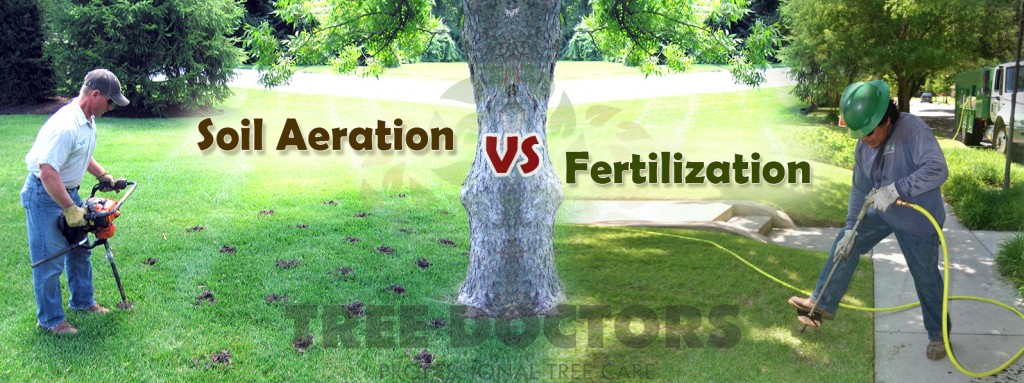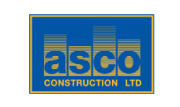I talk to many people throughout my work week who ask me for their trees to be fertilized. It doesn’t matter what kind of fertilizer, how it is administered, all they want is fertilizer! Although I agree that in most cases you will see a quick benefit with a good fertilizer that is administered at the right time of year, there may be another option that can yield a much better response from your trees. “Soil Aeration” – remember the last time you walked across a field or school yard and were stepping over millions of tiny holes in the turf? Well this method has been refurbished, refreshed, gotten a facelift (call it what you want) for the benefit to your trees, as there are more effective ways than “radial trenching” or other outdated methods that are slowly disappearing from the arboriculture industry. Aerating the soil can provide more benefits than just fertilizing.

What is it? Soil Aeration is essentially a soil replacement/restoration. We will remove the existing inadequate soil, and replace it with a new soil/compost blend which we incorporate fertilizer, and potentially sulfur (depending on the pH needs) and top dress with natural mulch. Now let’s talk about why:
– Amend/Repair Soil Compaction : If you have driven by a house that is having a renovation done anytime recently, you may recall the fences with orange plastic hording around all of the trees. This is the City’s way of recognizing the damage that is associated with soil compaction. Simply compacting the soil around the root zone of a tree can be as equally devastating to the health of the tree as completely severing the roots. Believe it or not, the tree’s root system needs more than just water and nutrients to survive. It needs air. The fibrous roots are unable to absorb nutrients and water without the presence of air. Most of the soil throughout the GTA is very dense with clay. Although clay soils will hold some benefits that will be mentioned later on, it is very easily compacted, which will cause declining health and provide the chance for pathogens to establish. Completing the service with a layer of mulch over the aerated soil adds to the betterment of the trees, which brings me to the next point
– Prevent Physical Damage: Enjoyable or not, mowing the lawn is a necessary chore for many of us. The turf at the base of the tree is sometimes the hardest to get to (round tree vs. square lawn mower…), and we often end up causing nicks and cuts to the bark of the tree. These small nicks can be disastrous over time, especially to thin bark trees (Birch, Beech, Serviceberry, Japanese maple, etc.), and even more so given the location close to the ground. The moisture held in the soil and grass will continue to come in contact with the wounds, and cause ongoing decay and cankers. That nice, aesthetically pleasing mulch ring that is around the base of the tree will provide a buffer to the tree, and even make that nasty chore a little easier.
– Promote Microbial Activity: Just below the surface of that mulch ring is a heap of activity. Where the mulch meets the newly aerated soil, the mulch is beginning to decompose. This decomposition is providing a food source for countless microbes and beneficial insects. In the same way that compost aids plants and trees, the mulch is improving the overall soil makeup around the tree, providing nutrients and building an environment where the undisturbed soil will continue to naturally aerate itself with the amount of beneficial insects that have found a new home.
– Improve Cation Exchange Capacity (C.E.C): Cation exchange capacity in general terms is a soil’s ability to retain individual nutrients. The healthier the soil, and more natural organic matter in a soil, the better the C.E.C. – a higher cation exchange capacity means a stronger positive charge in the soil, which will influence a higher potential capacity for negatively charged anions such as calcium, potassium and magnesium (all necessary for healthy plant foliage and defense and growth). In short, the more natural organic matter in the soil, the more nutrients the soil can hold. Clay soils tend to have a higher C.E.C, but as we have mentioned above, are more susceptible to soil compaction. The tree will not have use for all available nutrients at one time, so soil longevity if very important. If you live near the water in the GTA, chances are you’re living around sand based soils, which generally hold a low cation exchange capacity.
– Integrated Pest Management (IPM): If you have spoken to your certified arborist or master gardener recently, this may have been a term that you heard. The concept of a strong IPM program is to reduce the necessity for pesticides by keeping the trees and plants healthy enough to fight these pathogens naturally. If you’re reading this and thinking “well this is a bunch of high-hoping, wishful, waste of time” you’re wrong! Instead of just leaving it at that, I will add that all trees and plants have a natural ability to fight pests and fungi, much like our immune system. To further relate ourselves to the tree in your front yard, they become more susceptible to pathogens when they’re stressed. From my experience, the overwhelming majority of these stressors come from below the surface (or very close to, in regards to the root flare). The old practice of looking up at a tree to find the issues is dwindling, and many causes of these issues begin at the ground level (forgive the pun). Whether it is the over-mentioned “soil compaction”, root rot, or even a physical issue like a root crossing over the stem or another large root (called girdling roots), all of these issues can be amended with a soil aeration service.
This is an exciting time in our industry, with an increasing amount of very useful tools and knowledge to aid us in diagnosing current or potential issues in the landscape. We are also progressing into a much more environmentally cautious society where our concern of our green canopy is growing at the same rate as our intolerance for the overuse of pesticides. Pesticides and fungicides are becoming a last resort with rare exceptions, and a myriad of natural solutions are available. If you have any questions regarding the information above, or if you’re simply contemplating a new approach to your current landscape management, we will always be happy to assist. Call us now 416-201-8000 for a free consultation
Geoff Niblett
ISA Certification: ON 1719-A
Consulting Arborist – Tree Doctors Inc








